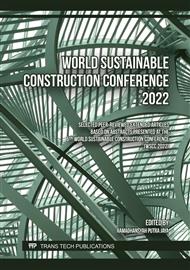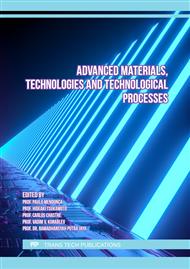[1]
P. Wong, S. N. A. Roslan, Construction and demolition waste management in malaysia construction industry- concrete waste management, Infrastructure. Univ. Kuala Lumpur Res. J. 7 (2019) 26–42.
Google Scholar
[2]
A.M. Alawag, W.S. Alaloul, M. S .Liew, M.A. Musarat, A. O. Baarimah, S, Saad, S. Ammad, Critical success factors influencing total quality management in industrialised building system: a case of Malaysian construction industry, Ain Shams Eng. J. (2022) 101877.
DOI: 10.1016/j.asej.2022.101877
Google Scholar
[3]
E. S. Rentier, L. H. Cammeraat, The environmental impacts of river sand mining, Sci. Total Environ. 838 (2022) 155877.
DOI: 10.1016/j.scitotenv.2022.155877
Google Scholar
[4]
H. Al-Thairy, Effect of using river sand on the strength of normal and high strength concrete, Int. J. Eng. Technol. 7 (2018) 222-228.
DOI: 10.14419/ijet.v7i4.20.25930
Google Scholar
[5]
P. R. Kalyana Chakravarthy, T. Ilango, R. Pugazhenthi, Mechanical properties of concrete with foundry sand and coconut shell as partial replacement for coarse and fine aggregate, Mat. Today Proceedings. 52 (2022) 537-543
DOI: 10.1016/j.matpr.2021.09.292
Google Scholar
[6]
Z, Li, J. Lao, L. Wang, N. S. Lim, K. H. Tan, S. Qian, A review on substitution of natural sand with granite fines in sustainable concrete, Constr. Build. Mater. 346 (2022) 128417.
DOI: 10.1016/j.conbuildmat.2022.128417
Google Scholar
[7]
S. Khaleghi, N. Surian, Channel adjustments in Iranian rivers: A review, Water (Switzerland), 11 (2019) 1–16.
DOI: 10.3390/w11040672
Google Scholar
[8]
A. Srivastava, S. K. Singh, Utilization of alternative sand for preparation of sustainable mortar: A review, J. Clean. Prod. 253 (2020) 119706.
DOI: 10.1016/j.jclepro.2019.119706
Google Scholar
[9]
P. Saiz Martínez, M. González Cortina, F. Fernández Martínez, A. Rodríguez Sánchez, Comparative study of three types of fine recycled aggregates from construction and demolition waste (CDW), and their use in masonry mortar fabrication, J. Clean. Prod. 118 (2016) 162–169.
DOI: 10.1016/j.jclepro.2016.01.059
Google Scholar
[10]
L. Tefa, M. Bassani, B. Coppola and P. Palmero, Strength development and environmental assessment of alkali-activated construction and demolition waste fines as stabilizer for recycled road materials, Constr. Build. Mater. 289 (2021) 123017.
DOI: 10.1016/j.conbuildmat.2021.123017
Google Scholar
[11]
M. Marzouk, S. Azab, Environmental and economic impact assessment of construction and demolition waste disposal using system dynamics, Resour. Conserv. Recycl. 82 (2014) 41–49.
DOI: 10.1016/j.resconrec.2013.10.015
Google Scholar
[12]
F.A. Salgado, F. de A. Silva, Recycled aggregates from construction and demolition waste towards an application on structural concrete: A review, J. Building Eng. 52 (2022) 104452.
DOI: 10.1016/j.jobe.2022.104452
Google Scholar
[13]
K. Xu, W. Huang, L. Zhang, S. Fu, M. Chen, S. Ding, B. Han, Mechanical properties of low-carbon ultrahigh-performance concrete with ceramic tile waste powder, Constr. Build. Mater. 287 (2021) 123036.
DOI: 10.1016/j.conbuildmat.2021.123036
Google Scholar
[14]
R.K. Goyal, V. Agarwal, R. Gupta, K. Rathore, P. Somani, Optimum utilization of ceramic tile waste for enhancing concrete properties, Mater. Today Proc. 49 (2021) 1769– 1775.
DOI: 10.1016/j.matpr.2021.08.011
Google Scholar
[15]
R. V. Meena, J. K. Jain, H. S. Chouhan, R. Mandolia, A. S. Beniwal, Impact of waste ceramic tile on resistance to fire and abrasion of self-compacting concrete, Mater. Today Proc. 60 (2022) 167–172.
DOI: 10.1016/j.matpr.2021.12.287
Google Scholar
[16]
S. Zhang, P. He, L. Niu, Mechanical properties and permeability of fiber-reinforced concrete with recycled aggregate made from waste clay brick, J. Clean. Prod. 268 (2020) 121690.
DOI: 10.1016/j.jclepro.2020.121690
Google Scholar
[17]
R. Arif, A. Khitab, M.S. Kirgiz, R.B. Nasar Khan, S. Tayyab, R.A. Khan, W. Anwar, M.T. Arshad, Experimental analysis on partial replacement of cement with brick powder in concrete, Case Stud. Constr. Mater. 15 (2021) e00749.
DOI: 10.1016/j.cscm.2021.e00749
Google Scholar
[18]
M. M. Atyia, M. G. Mahdy, M. Abd Elrahman, Production and properties of lightweight concrete incorporating recycled waste crushed clay bricks, Constr. Build. Mater. 304, (2021) 124655.
DOI: 10.1016/j.conbuildmat.2021.124655
Google Scholar
[19]
L. S. Ho, T. Huynh, Recycled waste medical glass as a fine aggregate replacement in low environmental impact concrete: Effects on long-term strength and durability performance, J. Clean. Prod. 368 (2022) 133144.
DOI: 10.1016/j.jclepro.2022.133144
Google Scholar
[20]
A. Tuaum, S. Shitote, W. Oyawa, Experimental study of self-compacting mortar incorporating recycled glass aggregate, Buildings. 8 (2018) 15.
DOI: 10.3390/buildings8020015
Google Scholar
[21]
J. Gupta, A. S. Jethoo, P. V. Ramana, Evaluating long term properties of concrete using waste beverage glass, Mater. Today Proc., 61 (2022) 297–306.
DOI: 10.1016/j.matpr.2021.09.446
Google Scholar
[22]
BS EN 12350-2, "Testing fresh concrete: Slump test," 2009.
Google Scholar
[23]
BS EN 12390-3, "Compressive strength of test specimens." 2001.
Google Scholar
[24]
BS 1881-122, "Method for determination of water absorption," 1983.
Google Scholar
[25]
P. P. Yalley, A. Sam, Effect of sand fines and water/cement ratio on concrete properties, Civil. Eng. Res. J. 4, (2018) 001-007.
Google Scholar
[26]
M.N.A. Ahmad Zawawi, K. Muthusamy, A.P.P Abdul Majeed, R.M. Musa, A.M.A. Budiea, Mechanical properties of oil palm waste lightweight aggregate concrete with fly ash as fine aggregate replacement. J. Building Engineering. 27 (2020) 100924.
DOI: 10.1016/j.jobe.2019.100924
Google Scholar
[27]
N. F. A. Jamaludin, K. Muthusamy, M. F. Md Jaafar, R. Putra Jaya, M. A. Ismail, Performance of palm oil clinker lightweight aggregate concrete comprising spent garnet as fine aggregate replacement, Adv. Civ. Eng. 2022 (2022) 9674096.
DOI: 10.1155/2022/9674096
Google Scholar
[28]
W. Zhang, X. Gu, J. Qiu, J. Liu, Y. Zhao, X. Li, Effects of iron ore tailings on the compressive strength and permeability of ultra-high performance concrete, Constr. Build. Mater. 260 (2020) 119917
DOI: 10.1016/j.conbuildmat.2020.119917
Google Scholar
[29]
A.M. Neville, Properties of Concrete, Fifth ed. Pearson Education Ltd, 2012.
Google Scholar



